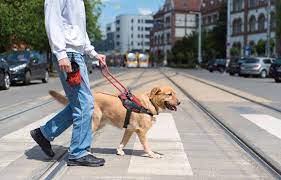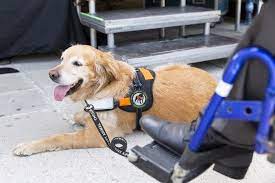Epilepsy is a neurological disorder that affects millions of individuals worldwide. Individuals with epilepsy confront many obstacles on a daily basis, and the unpredictable nature of seizures can have a substantial influence on their quality of life. Seizure response dogs are a great method to improve the lives of those living with epilepsy.
Table of Contents
Introduction
Seizure response dogs are professionally trained canines that provide individuals with essential support and help during and after seizures. We will delve into the world of seizure response dogs in this detailed article, studying their duties, training, advantages, and the incredible influence they have on the lives of people with epilepsy.
Understanding Epilepsy

Before we delve into the world of seizure response dogs, we must first understand epilepsy. Epilepsy is a chronic neurological condition characterized by unprovoked, repeated seizures. Aberrant electrical activity in the brain, which results in seizures, causes a variety of physical and cognitive symptoms. Convulsions, loss of consciousness, muscle jerks, and even altered sensations or emotions are examples.
Epilepsy is a condition that can affect people of all ages, genders, and ethnicities. The etiology of epilepsy is known in some circumstances, such as a head injury or a genetic susceptibility. Many cases, however, remain unexplained, and epilepsy can strike at any time in a person’s life. Managing epilepsy can be difficult, requiring drugs, lifestyle changes, and constant care.
Function of Seizure Response Dogs
Seizure response dogs, often known as epilepsy service dogs, play an important part in the lives of people who have epilepsy. These highly trained dogs are developed and selected expressly for their abilities to provide support and help during and after seizures. Their key responsibilities include:
- Seizure Warning

The capacity of epilepsy response dogs to anticipate seizures is one of their most impressive characteristics. While the specific mechanism is unknown, many people with epilepsy report that their dogs can detect an approaching seizure before it occurs. These dogs’ behavior can change, including heightened attentiveness, restlessness, and even licking and nuzzling their owners. This early warning allows those who have epilepsy to choose a safe environment and take preventive steps.
- Support During Seizures

Individuals with epilepsy may experience a variety of symptoms during a seizure, including convulsions and loss of consciousness. During seizures, seizure response service dogs are trained to stay close to their owners, providing physical support and comfort. They may, for example, lie down next to the individual to prevent injury or to provide emotional support during a distressing situation.
- Medication or Assistive Device Retrieval

Many patients with epilepsy rely on medication to keep their condition under control. Some people additionally employ medical equipment such as emergency alarms or communication gadgets. Seizure response dogs can be trained to fetch these items when their owners require them, ensuring quick access to vital equipment that can aid in the efficient management of the disease.
- Post-Seizure Support

Individuals with epilepsy may feel disoriented, weary, or puzzled after a seizure. Seizure response dogs help by staying near their owners and providing a sense of reassurance. They can also assist by notifying caretakers or medical experts as needed.
- Emotional Assistance

Epilepsy can be difficult emotionally and psychologically. Seizure response service dogs offer unconditional emotional support, assisting their owners in dealing with the stress and anxiety that typically accompany the condition. Their presence can be especially soothing in times of fear or sorrow.
Seizure Response Dog Training
Seizure response dogs are rigorously trained to develop the precise skills needed to assist people with epilepsy. The seizure response dog training process is divided into several important stages:
- Socialization in Childhood

Seizure response dogs are often trained as puppies. Early socialization is crucial for seizure response dog training and ensuring that they grow up to be well-adjusted, confident dogs. They are exposed to a variety of surroundings, people, and situations during this age in order to acquire a calm and adaptable disposition.
- Fundamental Obedience

The development of seizure response canines begins with basic obedience training. They learn basic instructions such as sit, stay, come, and heel, which are crucial for their own and their masters’ protection.
- Extensive Training

Seizure response dog advanced training entails specialized abilities targeted to the needs of people with epilepsy. This involves identifying and responding to the fragrance or behavioral changes that may precede a seizure.
- Emergency Preparedness Training

The capacity of epilepsy response dogs to alert their owners to an approaching seizure is one of their most amazing features. This skill is frequently acquired through intensive seizure response dog training, which may include exposure to seizure-related odors or monitoring specific behaviors in epileptics.
- Support Abilities

Seizure response dogs are also taught how to provide assistance during seizures. They are trained to stay near their masters, protect them from harm, and provide comfort.
- Retrieval Ability

These dogs are trained to fetch medication, emergency alarms, and other critical objects to aid with post-seizure treatment.
- Training for Public Access

Seizure response service dogs must be well-mannered in a variety of public settings. During seizure response dog training, they learn to navigate congested settings, public transportation, and other environments while staying attentive to their owners.
- Accreditation
Respectable organizations may certify seizure response dogs to provide the highest level of safety and effectiveness. A thorough evaluation of the dog’s skills and conduct, as well as an assessment of the dog-owner team’s ability to operate effectively together, is required for certification.
- Ongoing Training and Upkeep

After certification, training continues. Continuous training and maintenance are required to keep seizure response dogs alert and attentive to the needs of their owners. To sustain their usefulness, skills must be reinforced on a regular basis and exposed to different scenarios.
Advantages of Seizure Response Dogs

Individuals with epilepsy can benefit from seizure response dogs in a variety of ways. These advantages go far beyond the immediate help they provide during seizures:
- Enhanced Independence
Individuals with epilepsy can acquire more independence with the help of a seizure response dog. These canines can assist their owners with daily duties such as retrieving medication or notifying caregivers when necessary, helping them to live more self-sufficient lives.
- Increased Security
Seizure response service dogs serve an important role in keeping their owners safe during and after seizures. They can help prevent injuries and problems that may occur during a seizure, such as falling or choking.
- Forewarning
Seizure response dogs’ ability to predict seizures provides vital early warning. This not only allows people to prepare for seizures, but it can also help lower the general frequency of seizures, as some people report less seizure activity when they have a responsive canine friend.
- Emotional Assistance
Seizure response dogs provide incalculable emotional assistance. Living with epilepsy can be emotionally draining, but these dogs provide constant company and comfort. Their presence helps alleviate anxiety and despair, and many people find solace in their bond with their four-legged companions.
- Better Quality of Life
Individuals with epilepsy benefit from seizure response dogs’ increased overall quality of life. They provide both practical support and emotional well-being to their owners, allowing them to live more fulfilled lives.
Seizure Alert Dogs vs. Seizure Response Dogs
It is critical to distinguish between seizure response dogs and seizure alert dogs. While the terms are frequently used interchangeably, they refer to various aspects of epilepsy assistance.
- Seizure Response Canines

As stated in this article, seizure response dogs are trained to actively respond to seizures. They provide physical and emotional support during and after seizures, as well as activities such as medicine retrieval and alerting caregivers. These canines are not trained to predict seizures; rather, they are trained to aid when one occurs.
- Alert Dogs for Seizures

Seizure alert dogs have been specifically trained to detect seizures before they occur. These dogs are thought to have a more acute sense of smell or the ability to detect tiny changes in their owners’ behavior. When dogs detect an oncoming seizure, they may bark, whine, or exhibit certain behaviors to alarm their owners. The purpose is to notify people who have epilepsy to find a safe environment or take preventive actions. It should be noted, however, that not all canines can be trained to predict seizures, and the accuracy of this capacity differs between individuals and dogs.
Legal Considerations and Rights
Individuals who use seizure response dogs or seizure alert dogs are protected by laws in several countries that guarantee their access to public areas and lodgings. The Americans with Disabilities Act (ADA) defines service dogs in the United States as animals that have been properly trained to perform duties for the benefit of people with disabilities. Seizure response and seizure alert dogs are examples of this.
According to the ADA, people with epilepsy have the right to accompany their service dogs in any public setting where pets are typically not allowed. Restaurants, stores, and other public venues are included. These regulations are in place to ensure that disabled individuals have equal access to and opportunities in society.
Individuals with seizure response dogs or seizure alert dogs should be aware of their rights and obligations under their local rules, as the laws governing service dogs differ by nation.
How Much Do Seizure Response Dogs Cost?

While seizure response dogs bring enormous benefits to people with epilepsy, they are not without cost. The costs of acquiring and caring for a seizure response dog can be high, and those interested in obtaining one should be aware of these financial factors.
- Initial Training Expenses
The cost of purchasing a seizure response dog includes fees for the dog’s first training and certification. Depending on the training organization and the dog’s individual skills, this can range from several thousand to tens of thousands of dollars.
- Ongoing Maintenance and Care
After the dog is certified and put with its owner, there are ongoing expenditures to consider. These include food, veterinarian care, grooming, and other day-to-day expenses. It is critical to budget for the dog’s long-term care and well-being.
- Specialized Tools
Some people may require unique equipment, such as a harness or other supportive gear, for their seizure response dogs. When budgeting for a service dog, these fees should also be considered.
- Transportation and Lodging
Individuals who travel with their seizure response dogs may pay additional transportation and lodging costs. When organizing vacations or outings, it is critical to consider these costs.
- Protection
Seizure response dog insurance may be recommended to cover unexpected medical expenditures or other unanticipated occurrences. Insurance expenses should be factored into the total budget.
It is critical to investigate funding sources and financial assistance programs that may be available to assist with some of these fees. Some organizations and nonprofits may offer financial assistance to people with disabilities who require service dogs.
How to Choose a Seizure Response Dog
Choosing the best seizure response dog is an important decision. To ensure that the dog is well-suited to the individual’s needs and lifestyle, several things should be addressed during the choosing process:
- Organization for Training

It is critical to select a trustworthy training organization. Look for organizations that have a proven track record of training seizure response dogs and providing owners with continuing support. Investigate their techniques, success stories, and any qualifications they may have.
- Personality and Lifestyle Matching

Not all seizure response dogs are the same, so it’s critical to pick one whose attitude and energy level match the owner’s. Some dogs are more energetic and require more exercise, but others are calmer and prefer a quieter household environment.
- Breed and Size

Consider the dog’s size and breed. While there is no one-size-fits-all solution, based on their temperament and trainability, certain breeds are more typically utilized as seizure response dogs. Individual features, on the other hand, should take precedence.
- Education and Certification
Verify that a reputable organization has properly trained and certified the dog. Certification ensures that the dog has the required skills to properly aid people with epilepsy.
- Long-Term Dedication

A seizure response dog requires a long-term commitment that can last a decade or more. Consider the influence on your lifestyle and be prepared to be responsible for your dog’s care for the rest of its life.
Note: There might be affiliate links mentioned here. We may receive a commission if you purchase a product through an affiliate link. There is no additional charge for you. Please do your own research before making any online purchases.
Considerations for Ethical Behavior
While the benefits of seizure response dogs are obvious, there are some ethical concerns to consider. To ensure the well-being and efficacy of these dogs, training and care should be carried out in accordance with the highest ethical standards.
- Appropriate Training Procedures

To teach seizure response dogs, training organizations and trainers must employ humane and scientifically based training methods. The core of their instruction should be positive reinforcement and ethical training approaches.
- Breeding with Integrity

Breeding seizure-response dogs should prioritize the animals’ health and well-being. To limit the possibility of hereditary health disorders and to produce dogs with stable temperaments, ethical breeding techniques should be followed.
- Ongoing Monitoring and Care

Seizure response dog owners are responsible for providing continuing care, which includes regular veterinary check-ups, correct nourishment, exercise, and mental well-being. These pets’ physical and mental welfare must be prioritized.
- Consent and Limits
Individuals with epilepsy should respect their seizure response dogs’ boundaries. These animals have needs, and agreement is required in all interactions. When a dog is not feeling well, forcing them to do chores or provide emotional support can be damaging.
- General Awareness

It is critical to educate and raise public knowledge about the functions and rights of seizure response dogs. Understanding the significance of these animals and their functions can help to minimize misconceptions and ensure that their owners can freely access public spaces and lodgings.
FAQs
What exactly is a seizure response dog, and how do they aid people with epilepsy?
A seizure response dog is a specially trained canine that assists and supports people with epilepsy during and after seizures. They can anticipate seizures, aid during seizures, obtain medication or assistive gadgets, assist post-seizure, and provide emotional support.
Seizure response dogs anticipate seizures in what way?
The precise process by which seizure response dogs predict seizures is still being researched and debated. Many people with epilepsy claim that their dogs can detect imminent seizures through changes in behavior, scent, or other subtle signs.
Can seizure response dogs help prevent seizures?
Seizure response dogs are not trained to prevent seizures but rather to aid people who have them. However, their early warning capabilities may assist some people in taking preventive measures or finding a safe area before a seizure occurs.
What are the legal rights of those who have seizure response dogs?
In many countries, including the United States, there is legislation that protects people with seizure response dogs and grants them access to public places and accommodations. For instance, the Americans with Disabilities Act (ADA) specifies service dogs and grants people with disabilities the right to be with their service dogs in public places.
How does one go about getting a seizure response dog?
Typically, obtaining a seizure response dog entails contacting reputable training groups. To match individuals with the correct dog, the procedure may include applications, interviews, and evaluations. Training groups then collaborate with individuals to provide the dog with the appropriate training and certification.
What is the cost of getting and caring for a seizure response dog?
The cost can vary dramatically. The whole cost includes initial training expenditures, continuing care and maintenance, specialized equipment, and possibly insurance. It’s a good idea to look into financing possibilities and financial assistance programs that might be available to help offset some of these costs.
How long does it take to train a seizure response dog?
The length of training depends on the ability of the particular dog, the unique training structure, and the complexity of the abilities necessary. It may take many months to a year to thoroughly train a seizure response dog.
Are seizure response dogs and seizure alert dogs the same thing?
There is a distinction. Seizure response dogs are trained to aid their owners during and after seizures, whereas seizure alert dogs are trained to predict and warn their owners of imminent seizures. These two types of dogs have different skills and training goals.
What ethical concerns should be raised while training and caring for seizure response service dogs?
Humane training methods, appropriate breeding, constant care and monitoring of the dogs’ health, respecting their limits, and developing public knowledge about the duties and rights of seizure response dogs are all ethical factors.
Do seizure response dogs come from certain breeds, or can any breed be taught for this role?
While there is no precise breed requirement, because of their temperament and trainability, certain breeds are more typically utilized for seizure response dog training. Individual qualities and aptitude, on the other hand, are important considerations when selecting a suitable dog for this task.
Conclusion
Seizure response dogs are wonderful friends who play an important role in the lives of people who have epilepsy. They provide a sense of security, independence, and emotional support to their owners, considerably improving their quality of life. These canines enable people to live more full lives despite the problems of epilepsy by alerting to seizures, offering help, and providing steadfast company.
As the area of support animals evolves, it is critical to maintain high ethical standards in the training and care of seizure response dogs. We can continue to harness these dogs’ great potential to enhance the lives of people living with epilepsy by prioritizing their well-being and ensuring that they are treated with respect and care.
Seizure response service dogs are a brilliant example of the significant impact that the human-animal link can have on the lives of those suffering tough health issues in a society where empathy, support, and understanding are so important.












